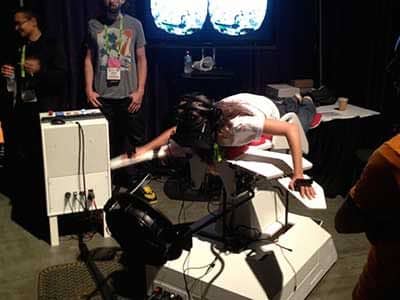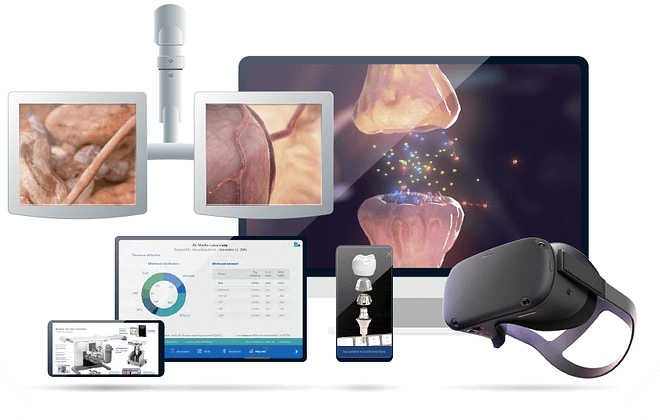A Worldwide Community of CG Artists
The SIGGRAPH conference is the premier international event on computer graphics and interactive techniques. This year our entire 3D team had the opportunity to trek up to Vancouver to take part in this incredible gathering of talent.
Regardless of our profession, most of us can think back to a moment when we realized what we wanted to do with our career. For the members of our 3D team, many of those moments occurred in movie theaters, seeing films like “Toy Story” or “Jurassic Park” for the first time. Because of its worldwide distribution, film production is some of the highest profile work a 3D artist can do. As a result, a question we’re frequently asked is how the work done by the Infuse 3D team differs from that done at a film studio. As we discovered at Siggraph 2014 this year, there are a lot more similarities than there are differences. This quarter, our entire 3D team had the opportunity to trek up to Vancouver, BC for three days of rubbing elbows with best and brightest in the industry. For most of us, this was our first opportunity to take part in digital graphic’s largest conference.

Our goal was simple: be inspired. It’s very easy to become so wrapped up in one’s own silo that work can become routine. That’s the beauty of conferences like Siggraph, where artists and technicians across the complete spectrum of digital graphics can come together and talk shop. The environment proved to be an incredible equalizer. From film students to CG supervisors to university professors, in that space everybody felt like they were on the same level. What was so interesting to our team was that when you get down to a purely production level, everyone in digital art faces similar challenges, be they technical or business related. The way those challenges manifest simply changes shape depending how big your team is and how big your budget is. Digital artists are nothing if not problem solvers, and being able to see and understand how other artists tackle their production challenges was indeed truly inspiring. Not because their approaches were so different than our own, but because they were so similar.
For a few members of our team, their adventure into the great white north began with a hike through Olympic National Park. The rest of us attempted to fly directly into Vancouver, but it proved to be somewhat more challenging than expected. Halfway into our second flight, the plane turned around and headed back to Portland. The captain informed us that the de-icers were not working on the wings, so we had to go back and get another plane. Thankfully that transition went relatively smoothly, but we ran into another hurdle when we finally arrived in Vancouver and were detained by customs for the better part of two hours. It was a completely surreal experience, because we were never told *why* we were being detained. A series of officers came by and checked our passports, then told us to keep waiting. We sat in a cold, incandescent room and watched other passengers being interrogated and/or deported. It was not a happy place. But we never felt any real sense of peril, because we genuinely had no idea what we were doing there. Finally after our two-hour wait, we were instructed to follow an officer. We did as we were told, and were eventually guided back out into the terminal. No explanation, we were simply free to go. When asked what we did wrong, the reply the officer gave us was simply that “United States citizens need to be granted entry to Canada.” And that was the end of it; almost six hours later than we expected to arrive we were finally into Vancouver. It was easily one of the most bizarre travel experiences I can claim to have taken part in.

What with our late arrival, we made a mad dash to our hotel, dropped off our bags and headed right to the convention center. After picking up our credentials, we still had time to attend an event called “Real-Time Live”. This was an opportunity for game developers and those working with real-time rendering engines (as Infuse does) to show off some of their best work. The Occulus Rift was the star of the show, as a variety of developers and students demonstrated new and novel uses of the technology. The best in show award winner was a demo called Birdy. Two developers created a peripheral that the user gets into while wearing the Occulus and simulates the experience of flying like a bird. The user flaps their wings to adjust their flight; there is even a fan in front of the user that changes its intensity based on how fast you are flying. Sadly, the lines at their booth were so long for the rest of the show that we never got to try it out personally.
On our second day at the show, we had the chance to see a number of “Production Sessions”. These were opportunities for teams from the large productions of the year to explain their process on those projects. We had the chance to hear from teams on “The Amazing Spiderman 2″, “Teenage Mutant Ninja Turtles”‘ “Gravity”, “Boxtrolls”, and “Killzone – Shadow Fall”. More than anything else, these sessions were our opportunity to see how similar the workflow is for artists on these large productions to our own. The size of the teams on most of these films/games was pretty staggering, not to mention the budgets. Perhaps the most impressive of all was realizing what a massive undertaking it is to coordinate such an army of CG artists on a feature film.
That evening we got to see a very unique part of the conference called “Dailies”. Think of it as a rapid-fire collection of short TED talks. It was a collection of short two-minute technical presentations on work submitted by a wide variety of artists, developers, and students. Our team all agreed this was one of the highlights of the show, because the work that was discussed was much more personal to the artist, as opposed to enormous scope of most of the production sessions. And again, it also was a great equalizer, because it helped our team realize any one of us could easily submit and present on the work we do with Infuse. The technical and artistic problems we solve within our team are every bit on the level of what we saw in the show.

The famous Siggraph Electronic Theatre was that night for most of us also. This is the event where Pixar debuted their first shorts several decades ago and changed the industry. It’s a film festival of the best work in CG from the past year, and finished with a full screening of “How to Train your Dragon 2″. While there was some great work on display in the theatre, nothing stood out as revolutionary. Probably evolutionary is a better word. Now almost twenty years from the release of the original “Toy Story”, the CG industry is fairly mature. The days of earth shattering advancement every year seems to have passed, and now what we see more of is incremental improvement – be it in motion capture, rendering, simulations, etc.
On our final day we had the chance to preview a new Disney short that will be released later this year called “Feast”. It was hands down the best piece of work we saw from our three days at the conference, both the presentation their team gave and the film itself. The film is largely about a dog’s relationship with food, and in the periphery of his food experiences, a whole story is told about the dog’s owner. The pacing, visual style, character design – all were top notch. It was a very inspiring hour and a half.
And with that our time at Siggraph had to draw to a close. We realized on the way out that we had largely neglected a whole area of the show called “Emerging Technologies”, which was described by one member of our team as “an adult science fair.” The description was very fitting, because it was really a playground of digital art projects created primarily by university students as research for the sake of research. We saw everything from a digital brush that paints elaborate images into shag carpets to all the newest uses of 3D printing. Our biggest regret was that we didn’t have more time to give to all the booths there. But just something to look forward to next year. Siggraph 2014 was a whirlwind of incredible presentations and talented people. It really felt like a global community of CG artists; no pretense or posturing, everybody was excited and enthusiastic to talk about their work and hear what their peers were doing. Our industry is very lucky to have an event where interaction like that can take place. For many of us, this may have been our first time to the show, but it won’t be the last!
Blog Categories
- Company News (33)
- Healthcare Operations (1)
- Industry News (19)
- Sales Enablement (2)
- Software Publishers (2)
- Virtual/Augmented Reality (2)



